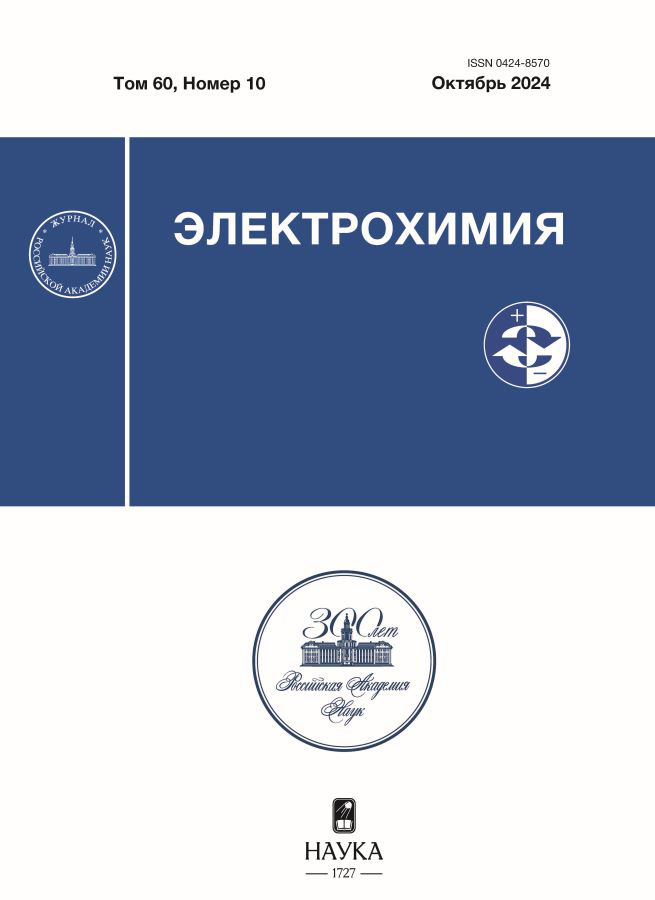Electrodeposited composite of poly-3,4-ethylenedioxythiophene with fullerenol photoactive in the near-IR range
- Authors: Gribkova O.L.1, Sayarov I.R.1, Kabanova V.A.1, Nekrasov A.A.1, Tameev A.R.1
-
Affiliations:
- Institute of Physical Chemistry and Electrochemistry named after A.N. Frumkin RAS
- Issue: Vol 60, No 10 (2024): Спецвыпуск “Электрохимия-2023”, часть 1
- Pages: 712-721
- Section: Articles by participants of the All-Russian Conference “Electrochemistry-2023” (Moscow, October 23–26, 2023)
- URL: https://medjrf.com/0424-8570/article/view/677611
- DOI: https://doi.org/10.31857/S0424857024100052
- EDN: https://elibrary.ru/OHJLRV
- ID: 677611
Cite item
Abstract
The electrochemical polymerization of 3,4-ethylenedioxythiophene in the presence of a water-soluble Na+-containing fullerene with hydroxyl groups was studied. Spectral methods for monitoring the progress of electrosynthesis have shown that during the polymerization of 3,4-ethylenedioxythiophene, fullerenol is included in the film composition, regardless of the fullerenol concentrations used in the synthesis. The electronic structure, morphology, spectroelectrochemical, electrochemical properties and near-IR photoconductivity of composite films of poly-3,4-ethylenedioxythiophene with fullerenol were studied for the first time. A mechanism of photoconductivity has been proposed, related to the fact that during photoexcitation of the composite, electron transfer from the polaron (bipolaron) state of poly-3,4-ethylenedioxythiophene to the LUMO level of fullerenol increases the concentration of photogenerated charge carriers.
Full Text
About the authors
O. L. Gribkova
Institute of Physical Chemistry and Electrochemistry named after A.N. Frumkin RAS
Author for correspondence.
Email: oxgribkova@gmail.com
Russian Federation, Moscow
I. R. Sayarov
Institute of Physical Chemistry and Electrochemistry named after A.N. Frumkin RAS
Email: oxgribkova@gmail.com
Russian Federation, Moscow
V. A. Kabanova
Institute of Physical Chemistry and Electrochemistry named after A.N. Frumkin RAS
Email: oxgribkova@gmail.com
Russian Federation, Moscow
A. A. Nekrasov
Institute of Physical Chemistry and Electrochemistry named after A.N. Frumkin RAS
Email: oxgribkova@gmail.com
Russian Federation, Moscow
A. R. Tameev
Institute of Physical Chemistry and Electrochemistry named after A.N. Frumkin RAS
Email: tameev@elchem.ac.ru
Russian Federation, Moscow
References
- Fan, B., Wang, P., Wang, L., and Shi, G., Polythiophene/Fullerene Bulk Heterojunction Solar Cell Fabricated via Electrochemical Co-Deposition, Sol. Energy Mater. Sol. Cells, 2006, vol. 90, p. 3547. https://doi.org/10.1016/j.solmat.2006.06.042
- Nasybulin, E., Cox, M., Kymissis, I., and Levon, K., Electrochemical Codeposition of Poly(Thieno[3,2-b]Thiophene) and Fullerene: An Approach to a Bulk Heterojunction Organic Photovoltaic Device, Synth. Met., 2012, vol. 162, p. 10. https://doi.org/10.1016/j.synthmet.2011.10.024
- Reynoso, E., Durantini, A.M., Solis, C.A., Macor, L.P., Otero, L.A., Gervaldo, M.A., Durantini, E.N., and Heredia, D.A., Photoactive Antimicrobial Coating Based on a PEDOT-Fullerene C60 polymeric Dyad, RSC Adv., 2021, vol. 11, p. 23519. https://doi.org/10.1039/d1ra03417k
- Suárez, M.B., Aranda, C., Macor, L., Durantini, J., Heredia, D.A., Durantini, E.N., Otero, L., Guerrero A., and Gervaldo, M., Perovskite Solar Cells with Versatile Electropolymerized Fullerene as Electron Extraction Layer, Electrochim. Acta, 2018, vol. 292, p. 697. https://doi.org/10.1016/j.electacta.2018.09.196
- Dominguez-Alfaro, A., Jénnifer Gómez, I., Alegret, N., Mecerreyes, D., and Prato, M., 2D and 3D Immobilization of Carbon Nanomaterials Into Pedot Via Electropolymerization of a Functional Bis-Edot Monomer, Polymers, 2021, vol. 13, p. 1. https://doi.org/10.3390/polym13030436
- Alegret, N., Dominguez-Alfaro, A., Salsamendi, M., Gomez, I.J., Calvo, J., Mecerreyes, D., and Prato, M., Effect of the Fullerene in the Properties of Thin PEDOT/C60 Films Obtained by Co-Electrodeposition, Inorganica Chim. Acta, 2017, vol. 468, p. 239. https://doi.org/10.1016/j.ica.2017.04.059
- Dumitriu, C., Mousavi, Z., Latonen, R.M., Bobacka, J., and Demetrescu, I., Electrochemical Synthesis and Characterization of Poly(3,4- Ethylenedioxythiophene) Doped with Sulfonated Calixarenes and Sulfonated Calixarene-Fullerene Complexes, Electrochim. Acta, 2013, vol. 107, p. 178. https://doi.org/10.1016/j.electacta.2013.05.140
- Bobylev, A.G., Kornev, A.B., Bobyleva, L.G., Shpagina, M.D., Fadeeva, I.S., Fadeev, R.S., Deryabin, D.G., Balzarini, J., Troshin, P.A., and Podlubnaya, Z.A., Fullerenolates: Metallated Polyhydroxylated Fullerenes with Potent Anti-Amyloid Activity, Org. Biomol. Chem., 2011, vol. 9, p. 5714. https://doi.org/10.1039/c1ob05067b
- Husebo, L.O., Sitharaman, B., Furukawa, K., Kato, T., and Wilson, L.J., Fullerenols Revisited as Stable Radical Anions, J. Amer. Chem. Soc., 2004, vol. 126, p. 12055. https://doi.org/10.1021/ja047593o
- Troshin, P.A., Astakhova, A.S., and Lyubovskaya, R.N., Synthesis of Fullerenols from Halofullerenes, Fullerenes Nanotub. Carbon Nanostructures, 2005, vol. 13, p. 331. https://doi.org/10.1080/15363830500237192
- Namazian, M., Lin, C.Y., and Coote, M.L., Benchmark Calculations of Absolute Reduction Potential of Ferricinium/Ferrocene Couple in Nonaqueous Solutions, J. Chem. Theory Comput., 2010, vol. 6, p. 2721. https://doi.org/10.1021/ct1003252
- Krukiewicz, K., Kruk, A., and Turczyn, R., Evaluation of Drug Loading Capacity and Release Characteristics of PEDOT/Naproxen System: Effect of Doping Ions, Electrochim. Acta, 2018, vol. 289, p. 218. https://doi.org/10.1016/j.electacta.2018.09.011
- Gribkova, O.L. and Nekrasov, A.A., Spectroelectrochemistry of Electroactive Polymer Composite Materials, Polymers, 2022, vol. 14, p. 3201. https://doi.org/10.3390/polym14153201
- Garreau, S., Duvail, J.L., and Louarn, G., Spectroelectrochemical Studies of Poly(3,4-Ethylenedioxythiophene) in Aqueous Medium, Synth. Met., 2001, vol. 125, p. 325. https://doi.org/10.1016/S0379–6779(01)00397–6
- Zozoulenko, I., Singh, A., Singh, S.K., Gueskine, V., Crispin, X., and Berggren, M., Polarons, Bipolarons, and Absorption Spectroscopy of PEDOT, ACS Appl. Polym. Mater., 2019, vol. 1, p. 83. https://doi.org/10.1021/acsapm.8b00061
- Janssen, R.A.J., Smilowitz, L., Sariciftci, N.S., and Moses, D., Triplet-State Photoexcitations of Oligothiophene Films and Solutions, J. Chem. Phys., 1994, vol. 101, p. 1787. https://doi.org/10.1063/1.467757
- Peintler-Kriván, E., Tóth, P.S., and Visy, C., Combination of in Situ UV–Vis-NIR Spectro-Electrochemical and a. c. Impedance Measurements: A New, Effective Technique for Studying the Redox Transformation of Conducting Electroactive Materials, Electrochem. commun., 2009, vol. 11, p. 1947. https://doi.org/10.1016/j.elecom.2009.08.025
- Kabanova, V., Gribkova, O., and Nekrasov, A., Poly(3,4-Ethylenedioxythiophene) Electrosynthesis in the Presence of Mixtures of Flexible-Chain and Rigid-Chain Polyelectrolytes, Polymers, 2021, vol. 13, p. 3866. https://doi.org/10.3390/polym13223866
- Nekrasov, A.A., Nekrasova, N. V., Savel’ev, M.A., Khuzin, A.A., Barachevsky, V.A., Tulyabaev, A.R., and Tuktarov, A.R., Electrochemical Investigation of a Photochromic Spiropyran Containing a Pyrrolidinofullerene Moiety, Mendeleev Commun., 2023, vol. 33, p. 505. https://doi.org/10.1016/j.mencom.2023.06.021
- Meskers, S.C.J., van Duren, J.K.J., and Janssen, R.A.J., Stimulation of Electrical Conductivity in a π-Conjugated Polymeric Conductor with Infrared Light, J. Appl. Phys., 2002, vol. 92, p. 7041. https://doi.org/10.1063/1.1519948
Supplementary files




















